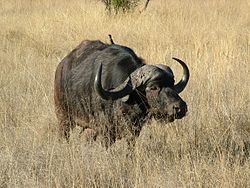In Africa, the Big Five game animals are the lion, leopard, rhinoceros, elephant, and African buffalo. The term was coined by big-game hunters to refer to the five most difficult animals in Africa to hunt on foot, but is now more widely used by game viewing tourists and safari tour operators. They are examples of charismatic megafauna, featuring prominently in popular culture, and are among the most famous of Africa's large animals.
African buffalo

The African buffalo (Syncerus caffer) is a large horned bovid. It is the only animal among the Big Five that is not on the "endangered" or "threatened" list. The Cape buffalo (Syncerus caffer ) is considered by many to be the most dangerous of any of the Big Five: buffalos have reportedly been known to ambush and attack humans.
Elephant

The African bush elephant (Loxodonta africana) and the African forest elephant (Loxodonta cyclotis) are the largest extant land-based animals. Elephants are herbivores with thick, almost hairless skin; a long, flexible, prehensile trunk; upper incisors forming long, curved, ivory tusks; and large, fan-shaped ears. Elephants are difficult to hunt because, despite their large size, they are able to hide in thick bush and are more likely to charge than the other Big Five species. They become aggressive when their young are threatened
Rhinoceros.

The black rhinoceros (Diceros bicornis) and the white rhinoceros (Ceratotherium simum) are large herbivores with two upright horns on their nasal bridge. The black rhino is classified as critically endangered and the white rhino as near threatened, and both are subject to extensive poaching. Among big-five game hunters, the black rhinoceros is more highly prized. The current existing rhinos throughout the savanna are southern white rhinoceros, eastern black rhinoceros, south-western black rhinoceros and south-central black rhinoceros.
Lion

The lion (Panthera leo) is a large, carnivorous feline found in both Africa and northwestern India. It has a short, tawny coat; a tufted tail; and, in the male, a heavy mane around the neck and shoulders. As a large and charismatic apex predator with cultural significance, lions are among the most popular species to view on safari tours.
Leopard

The leopard (Panthera pardus) is a large, carnivorous feline. Its fur is generally tawny with dark rosette-shaped markings. The leopard is the most seldom seen of the Big Five because of its nocturnal habits (it is most active between sunset and sunrise, although it may hunt during the day in some areas), and because it is wary of humans and will take flight in the face of danger. Leopards can be located in the grasslands, dense brushes, deserts, and forested areas of African savannas.
The above are the big five game of Africa. The "Big Five" – lion, leopard, rhinoceros, elephant, and buffalo – can be found in numerous locations across Africa, but some of the most popular and reliable destinations include; South Africa's Kruger national park, Tanzania's Serengeti and Ngorongoro Crater, Kenya's Masai Mara, and Botswana's Chobe national park.
In Uganda, apart from the rhinos at Ziwa Rhino sanctuary, other big five animals are found in almost all savannah parks of the country.
.